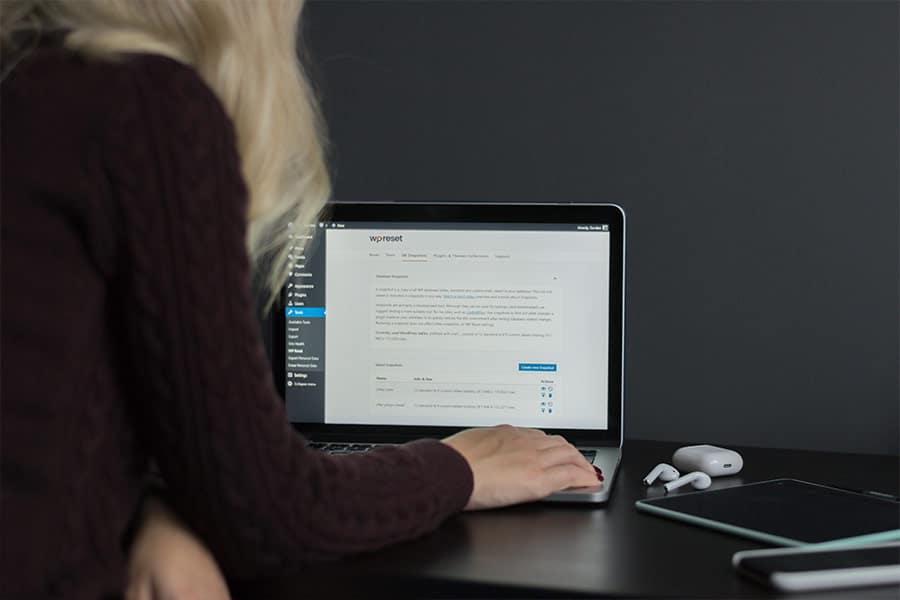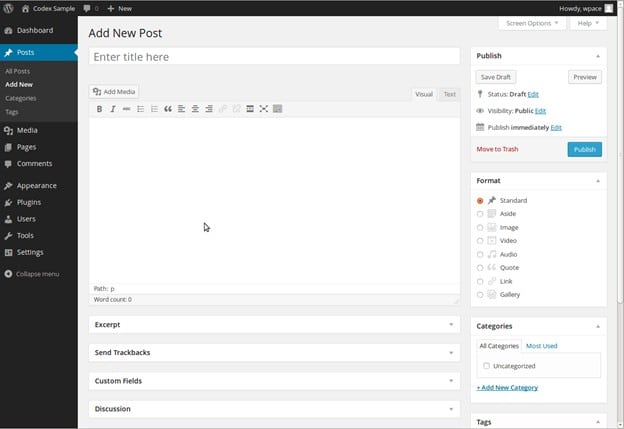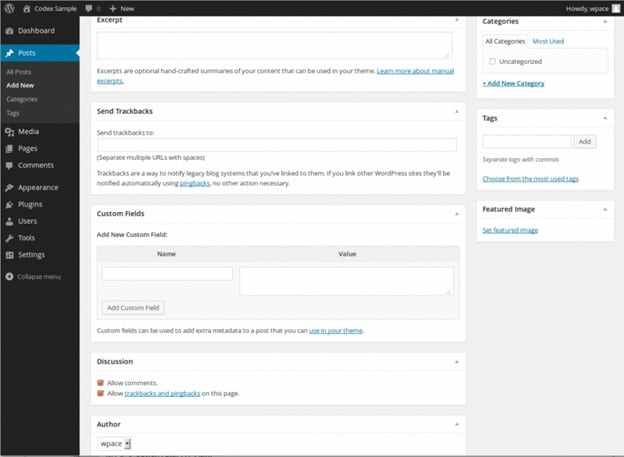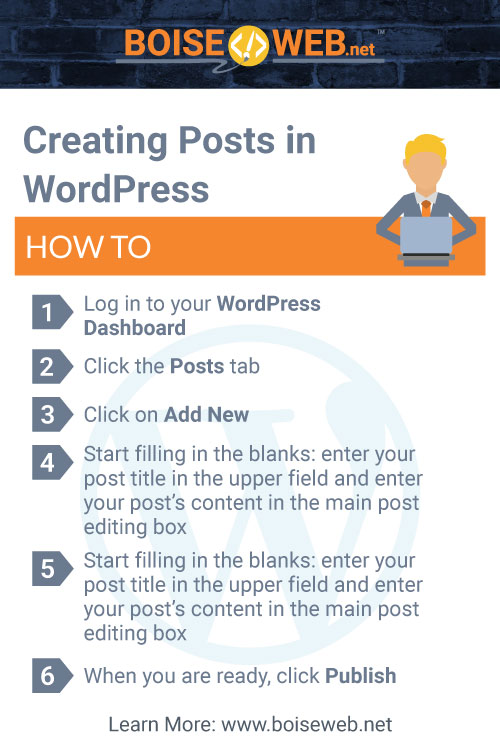Posts are entries on your site that will display in reverse order on your home or blog page, meaning the newest entry will be listed first. Posts also usually come with a comments section to allow readers to interact with your page.
How to Write a Post in WordPress
- Log in to your WordPress Dashboard
- Click the Posts tab
- Click on Add New
- Start filling in the blanks: enter your post title in the upper field and enter your post’s content in the main post editing box
- As needed you can select a category, add tags, and make other selections from the sections below the post
- When you are ready, click Publish
Screen Options
There are more editing fields available to you than the ones that first pop up on screen. At the very top of your screen you will see a Screen Options button, when clicked on this will show you a list of all available editing fields. This allows you to minimize clutter and customize your posts to your individual needs. You can check the boxes of the fields you want to include and uncheck the boxes of the fields that you would like to remove from your post.
Post Field Descriptions
Title/Headline Box
This box should contain the title of your post. You can use any phrase, words, or characters, but avoid using the same name for more than one post. You can use commas, apostrophes, quotes, hyphens/dashes, and other symbols in the post. WordPress will then clean it up to generate a user-friendly and URL-valid name of the post (also called the “post slug”) to create the permalink for the post.
Permalink
The permalink is automatically generated based on the title you set to the post and is shown below the title field. Punctuation such as commas, quotes, apostrophes, and invalid URL characters are removed, and spaces are substituted with dashes to separate each word. This post name, referred to as “post slug” or just “slug”, can be edited depending on your Permalinks settings using the “Edit” button.
Body Copy Box
This is the blank text box that you enter the body of your post into. Any images, links, and copy that you want to be displayed on your site will go here.
Publish Box
Contains buttons that control the state of your post. The main states are Draft and Published. Draft means the post has not been published and remains in draft status for the post creator. A Published status means the post has been published and is live on your site.
- Preview Button – Allows you to view the post before publishing.
- Save Draft – Allows you to save your post as a draft rather than immediately publishing it. To return to your drafts later, visit Posts -> Edit in the menu bar.
- Status – If you select a specific publish status and click the update post or publish button, that status is applied to the post. For example, to save a post in the Pending Review status, select pending review from the publish status drop-down box, and click Save As Pending.
- Visibility – This determines how your post appears to the world. Public posts will be visible by all website visitors once published. Password protected posts are published to all, but visitors must know the password to view the post content. Private posts are visible only to you and to other editors or admins within your site.
- Revisions – Click Browse to see all of the changes you’ve made to your post.
- Scheduling – To schedule a post for publication on a future time or date, click Edit next to the words Publish immediately. You can also change the publish date to a date in the past to back-date posts. Click the Publish button when you have completed the post to publish at the desired time and date.
Format Box
Allows you to select a format for your post. Individual styling and appearance is handled by the theme and will vary from format to format.
Categories Box
This allows you to add categories to your post. These are based on the general topic of your post and it isn’t uncommon for blog posts to have upwards of 10 category tags.
Tags Box
These are micro-categories for the post, similar to including index entries for a page. Posts with similar tags are linked together when a user clicks one of the tags. Tags have to be enabled with the right code in your theme for them to appear in your post. Add new tags to the post by typing the tag into the box and clicking “Add.” You can also click on the “Choose from the most-used tags” link to see all of the tags used by the site.
Excerpt
A summary or brief teaser of your post that may appear on the front page of your site as well as on the category or archives pages. Note: the excerpt does not usually appear by default, it will typically only appear in your post if you have modified the template file.
Send Trackbacks
This is a way to notify blog systems that you’ve linked to them. If you link other WordPress blogs, they’ll be notified automatically using pingbacks. No other action is necessary. For those blogs that don’t recognize pingbacks, you can send a trackback to the blog by entering the website address(es) in this box, separating each one by a space.
Custom Fields
Custom fields offer a way to add information to your site. In conjunction with extra code in your template files or plugins, custom fields can modify the way a post is displayed. These are primarily used by plugins, but you can manually edit that information in this section.
Discussion
This section controls the level of interaction other people will be able to have with your page. This section hosts two check boxes: Allow Comments on this post and Allow trackbacks and pingbacks on this post. If unchecked, comments will be disabled for the post and you will not be notified if other blogs link back to your page.
Post Author
A list of all blog authors you can select from to attribute as the post author. This section only shows if you have multiple users with authoring rights in your blog. To view your list of users, see Administration Panel -> Users.
Best Practices for Posting
- Practice accessibility
- To be compliant with web standards regarding accessibility all of your links and images should have ALT and TITLE descriptions.
- Use paragraphs
- No one wants to read through a solid wall of text, break up your writing with paragraphs to improve user experience
- Use headings
- Especially if your post is particularly long, headings can help break up information and smaller sub-headings or small titles can be used to indicate a topic change within a singular heading
- Spell check
- It sounds self-explanatory but ensuring your post has proper spelling and grammar all the way through is crucial.




